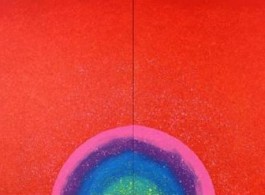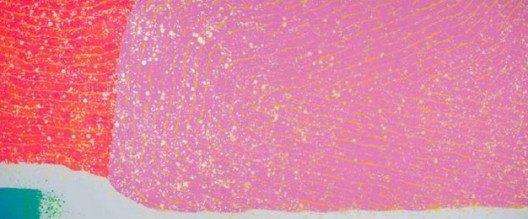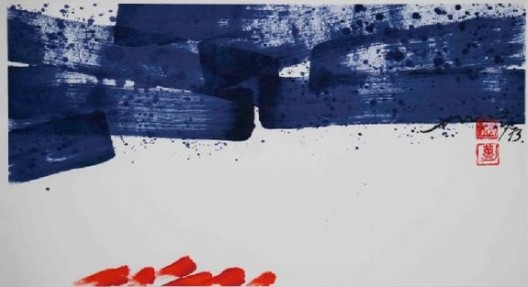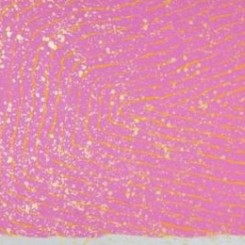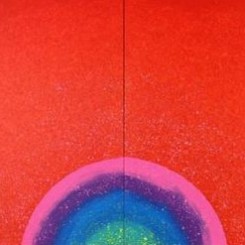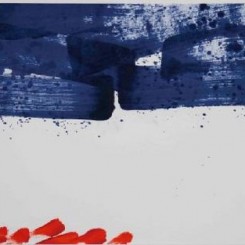The Exhibition Opening will be held at 3812 Gallery on 15 March, with presence of the artist, who will host an art talk – “Hsiao Chin: Abstract, Extending the Oriental Spirit”.
3 March, 2016, Hong Kong. Master artist Hsiao Chin is celebrated as the pioneer of modern abstract art in Taiwan, and is widely-recognised in both Eastern and Western art scenes for his major contribution to the development of Chinese modern abstract art. He was a leading member in the establishment of the Ton Fan Art Group (Eastern Painting Society) in Taiwan in 1956, which was acclaimed as the first abstract art group in the Chinese community. In the 1950s he started exploring an abstract art which was based on his core concept of ‘Eastern Spirit.’ Merging Eastern philosophies and aesthetics with the Western dialectical approach of self-reflection, Hsiao has established his own artistic approach as well as a unique vision on how art should be created.
Born in 1935 in Shanghai, Hsiao moved to Taiwan with his uncle’s family in 1949 and took up formal artistic training in 1951. He moved to Europe in 1956. Like his senior masters Lin Fengmian and Zao Wou-ki (Zhao Wuji) who travelled to France, Hsiao Chin was motivated by Western abstract art during his stay in Spain and subsequent moved to Italy, but developed an interest in Zen and Taoism – in particular the ideas of Lao Tzu and Chuang Tzu – around the 1960s. He became a pioneer of the first-wave Modern Art Movement of post-war Taiwan. Drawing artistic nourishment from these aspects of traditional Chinese culture, Hsiao has showed great ambition to develop his own style of abstract painting, which would be at once distinguishable from, yet reflective of, Western abstract art at that time.
Having lived and worked abroad for over 60 years, Hsiao has been successfully integrating his extensive studies of Western aesthetics, Eastern philosophies, and his interest in space science in his artistic creation. With the efforts of self-discovery and a spiritual quest for transcendence, Hsiao’s creative process is rooted in his perpetual exploration of the deepest meanings in man’s spiritual world.
Hsiao Chin’s paintings continuously project a sense of endless energy, and this mirrors the artist’s belief that life is also an endless process of learning. Last year at his retrospective exhibition Eighty Years of Energy in National Taiwan Museum of Fine Arts, Hsiao suggested that:
One should always try to explore the limited physical space to the maximum and to generate maximum energy in the confines of space, to learn in a material world that transcends the boundaries of time, and in so doing to grasp the deeper meanings of life. And it is through my awkward brush work and the bright primary colours that I achieve such goals.
On a personal level, for the artist, the purpose of Hsiao Chin’s art creation is:
“To express…my tireless efforts at self-reflection and introspection. In the meanwhile, I want to communicate with viewers my learning and understanding of this infinitely evolving universe, hoping that I may gain even deeper and broader knowledge in return.”
3812 Gallery proudly presents Endless Energy: Hsiao Chin Solo Exhibition, a retrospective exhibition which provides collectors and art lovers a unique opportunity to collect and appreciate the artist’s important works throughout his artistic career from 1963 to 2014, including those on canvas and on paper. Hsiao’s canvas-based works in the 1960s and paper-based works in the early 1970s capture rhythms of light by incorporating curved or straight bold lines and shapes, and reveal Eastern spirituality through abstract symbols and penetrative, blank spaces. His Chi series from the late-1970s to the 1980s features broad and powerful brushwork to convey the flows of energy in the universe. As for his remarkable Samantha’s Ascension, Transcending beyond the Great Threshold, and Eternal Garden series in the 1990s, he made use of even more vibrant colours, dramatic compositions and free-flowing lines. These expressions stemmed from Hsiao’s emotional depression and his spiritual transcendence afterwards, since losing his daughter Samantha in a tragic accident in 1990.
After 2000, many of Hsiao’s works repeatedly emphasised his idea of the grand energy of the universe by making use of scattering dots on strong cold and warm colour fields, referring to not only the internal energies of galaxies and planets, but more importantly the human consciousness of harmony between the universe and human lives. With the endless adventure of abstract art and self-reflection, throughout his lifetime Hsiao has been pursuing the ideal realm of “Nature and Man in One” greatly beyond the boundaries of life and death.

